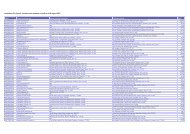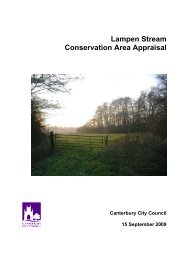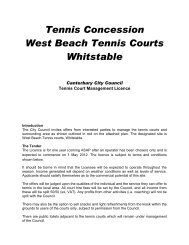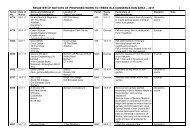Chutneys, pickles, jams and oils leaflet - Canterbury City Council
Chutneys, pickles, jams and oils leaflet - Canterbury City Council
Chutneys, pickles, jams and oils leaflet - Canterbury City Council
You also want an ePaper? Increase the reach of your titles
YUMPU automatically turns print PDFs into web optimized ePapers that Google loves.
This quick guide provides a summary of food safety <strong>and</strong>labelling advice for small scale home producers of chutneys,<strong>pickles</strong>, flavoured <strong>oils</strong> <strong>and</strong> <strong>jams</strong>.General Food Safety AdviceRegistrationFood business operators need to register their food business with the local authority wherethey are based 28 days before trading. This is a legal requirement <strong>and</strong> is free of charge.Please contact your local authority for more information.General HygieneAnyone who prepares <strong>and</strong> sells food (even for one‐off events) is required to make sure thefood they supply is safe to eat. The ingredients used, the premises in which the products aremade, the method of production <strong>and</strong> the person making the food all have an impact on thesafety <strong>and</strong> quality of the final product.How well you comply with the law will be assessed by the inspecting officer when he/shecarries out routine hygiene or food st<strong>and</strong>ards inspections or when collecting food samples.More information on food inspections can be found at:http://www.food.gov.uk/multimedia/pdfs/publication/foodlawinspec0310.pdfFood Hygiene TrainingFood h<strong>and</strong>lers should be trained, supervised <strong>and</strong>/or instructed to a level appropriate to theirwork activities.To fulfil this legal requirement, it is recommended that food h<strong>and</strong>lers undertake training to alevel equivalent to the Chartered Institute of Environmental Health’s Level 2 Award in FoodSafety. More information on food hygiene courses can be found by contacting us or yourlocal college.Food Safety ManagementEven if you are a small business the law requires you to have a documented food safetymanagement system based on the principles of HACCP (Hazard Analysis <strong>and</strong> Critical ControlPoint). This is a way of managing food safety ‘hazards’ in your business. The procedures needto be appropriate for the nature <strong>and</strong> size of your business <strong>and</strong> must be kept up to date. Youwill also need to review your procedures from time to time, especially when somethingchanges.Produced by Kent Food Group 20121
HACCP is a preventative approach to food safety management based on the following sevenprinciples:1 identify what could go wrong (the hazards)2 identify the most important points where things can go wrong (the critical controlpoints – CCPs)3 set critical limits at each CCP (e.g. cooking temperature/time)4 set up checks at CCPs to prevent problems occurring (monitoring)5 decide what to do if something goes wrong (corrective action)6 prove that your HACCP Plan is working (verification)7 keep records of all of the above (documentation)The Food St<strong>and</strong>ards Agency has developed Safer Food, Better Business for small catering <strong>and</strong>retail businesses to help businesses comply with food hygiene regulations. Many small foodbusinesses will be able to have simple procedures <strong>and</strong> simple records. More informationcan be found athttp://www.food.gov.uk/foodindustry/regulation/hygleg/hyglegresources/sfbb/The European Commission has also provided a guidance document for businesses regardingHACCP athttp://ec.europa.eu/food/food/biosafety/hygienelegislation/guidance_doc_haccp_en.pdfWhat are the hazards?Clostridium botulinumClostridium botulinum is a type of bacteria that grows under anaerobic conditions (i.e.without air) <strong>and</strong> can produce a harmful toxin (poison) in food which causes the seriousillness botulism. This is a potentially fatal form of food poisoning, although it is rare in theUK. The spores of C. botulinum are widely distributed in the environment <strong>and</strong> may bepresent in a range of foods, including fruit or vegetable ingredients used to make chutneys,<strong>jams</strong>, <strong>pickles</strong> <strong>and</strong> flavoured <strong>oils</strong>. Storing these products in sealed bottles (<strong>and</strong> particularlystoring them in oil) can create the right conditions for the bacteria to multiply <strong>and</strong> producebotulinum toxin.Due to the high sugar content in jam <strong>and</strong> the acidic nature of chutneys, <strong>pickles</strong> <strong>and</strong> flavouredvinegars, any harmful <strong>and</strong>/or spoilage bacteria are unlikely to grow. Because some fungi aremore tolerant of acid <strong>and</strong> or high sugar conditions, there is a small possibility of themgrowing, depending on the recipe, how the product is made <strong>and</strong> stored as well as how long<strong>and</strong> under what conditions it is kept once opened.Flavoured <strong>oils</strong> are different because they are not acidic. Outbreaks of Clostridium botulinumhave been associated with flavoured <strong>oils</strong> because they normally have a pH higher than 4.5<strong>and</strong> the oil provides an air‐free environment for the spores to germinate <strong>and</strong> the bacteria tomultiply <strong>and</strong> produce toxin. Trace amounts of moisture could create an environment forbacteria to survive <strong>and</strong> grow, <strong>and</strong> this can potentially be added in the form of vegetables,spices, herbs or bottles that have not been thoroughly dried.Produced by Kent Food Group 20122
MouldsMoulds <strong>and</strong> yeasts can contaminate products if the jars, bottles or lids are not clean or if theproduct is not sealed quickly after filling. Growth can then occur once the product is opened<strong>and</strong> exposed to air.Physical contaminationCracked or chipped jars, bottles or damaged lids can cause physical contamination of theproduct as can foreign objects harvested with fruit <strong>and</strong> vegetables e.g. stones, slugs <strong>and</strong>insects. There may also be an increased risk of microbiological contamination.What should I do to control the hazards?For all products• Wash your h<strong>and</strong>s before preparing or h<strong>and</strong>ling food.• Ensure chopping boards, pans <strong>and</strong> utensils are clean <strong>and</strong> kept in good condition.• Use clean disinfected jars/bottles <strong>and</strong> invert them after disinfection until you are readyto fill them, to prevent foreign body contamination. Disinfect them by placing them inthe oven (10 minutes at gas mark 3/160°C), by passing them through the hot cycle ofthe dishwasher or submerging them in hot water (above 90°C) for 10 minutes. The jarsor bottles must be fully dry before use.• Store products in a cool, dry environment.• Unless you have undertaken independent analysis it is difficult to determine anappropriate shelf life for your product. Some recipes give an indication of shelf life butthis may not have been assessed by a microbiological laboratory. Never exceed theshelf life <strong>and</strong> it would be sensible to give your products a shorter shelf life than statedunless you have used an accredited microbiological laboratory to undertake a shelf lifestudy.• Always stick to st<strong>and</strong>ard recipes <strong>and</strong> cooking methods; the amount of vinegar <strong>and</strong>/orsugar is essential for safety. For example, ensure weights of ingredients are known <strong>and</strong>follow instructions on how long to boil/simmer each batch.• Keep records of each batch produced. This would typically include the food name, dateof production, number of jars/bottles produced, use by or best before date, lot or batchnumber, records of any temperatures or pH measurements. If you supply otherbusinesses, you must be able to identify what you have supplied them with in case youneed to recall the food in the event of a problem.For <strong>jams</strong>, <strong>pickles</strong> <strong>and</strong> chutney• Thoroughly wash, dry <strong>and</strong> where necessary peel fresh fruit, vegetables <strong>and</strong> herbs.• Ensure lids/stoppers are clean <strong>and</strong> tight fitting but do not re‐use lids. Lids must be puton immediately after bottling, whilst the product is still hot for the vacuum seal to beformed.Produced by Kent Food Group 20123
• Use a jam thermometer to ensure the jam is heated to the correct temperature (settingpoint). Jam sets around 105°C. Heating to this temperature will destroy a significantnumber of harmful bacteria. The setting point of low sugar <strong>jams</strong> will vary.• For <strong>pickles</strong> <strong>and</strong> chutneys, it is important to ensure the pH is 4.5 or lower <strong>and</strong>/or thewater activity is below 0.9 throughout the product during the shelf‐life to control therisk of C. botulinum. If this cannot be guaranteed, products should be stored in arefrigerator, even before they are opened.Extra controls for flavoured <strong>oils</strong>• Then making <strong>oils</strong>, use dried herbs, spices <strong>and</strong> vegetables to ensure that moisture levelsare kept to a minimum or thoroughly dry ingredients well before adding. The bottlesused should be completely dry before use to store flavoured <strong>oils</strong>.• Ensure that the pH is consistently pH 4.5 or lower throughout the product including theadded ingredients. Acids including phosphoric, citric or acetic acid can be added to <strong>oils</strong>to help reduce the pH. pH meters should be used. Litmus paper can offer a guide but isnot very accurate. This is a critical control point <strong>and</strong> must be followed to protectconsumer safety.• The maximum shelf life of the product should be 10 days. It can be kept for longer if thepH is shown to be 4.5 or lower for the duration of its shelf‐life. This must be determinedby independent analysis.Food LabellingFull details on how to comply with labelling requirements can be found in the Food LabellingRegulations 1996. Changes that will amend the general labelling requirements are beingdeveloped. Please check with Kent Trading St<strong>and</strong>ards to see how the changes may affectyour business.If you are selling food via another retailer, the food is considered to be sold pre‐packed<strong>and</strong> must be labelled with the following information:• Name of the food – a name sufficient to inform a purchaser of the food’s true nature<strong>and</strong> distinguish it from other products with which it could be confused or a reserveddescription (see below under jam, jelly <strong>and</strong> marmalade).• List of ingredients ‐ in descending order by weight.• Percentage quantity declaration for any ingredients given emphasis on the label such asin the name of the food or by pictures e.g. apricot chutney would require a declarationof the percentage of apricot used.• A best before or use by date. ‘Use by’ dates relate to food safety <strong>and</strong> ‘best before’ tofood quality. Flavoured <strong>oils</strong> should have a use by date.Produced by Kent Food Group 20124
• Any special storage conditions or instructions for use (e.g. flavoured <strong>oils</strong> ‘store in thefridge below 8°C before <strong>and</strong> after opening’).• The name <strong>and</strong> address of the manufacturer, packer or seller.• Any specified allergens or ingredients derived from the allergens must be clearlydeclared in the ingredients list if they are not already in the name of the food. Thespecified allergens are cereals containing gluten, crustaceans <strong>and</strong> molluscs, eggs, fish,soybeans, milk, peanuts, nuts, celery, mustard seeds, sulphur dioxide <strong>and</strong> sulphites(above 10mg/kg or 10mg/L), sesame seeds <strong>and</strong> lupin. More information on foodallergen labelling can be found on: http://www.food.gov.uk/safereating/allergyintol/label/• If any ingredient that has been irradiated or genetically modified this must be declared.Food sold pre‐packed for direct sale does not require full labelling, only a declaration of thecategory name of any additives (antioxidants, artificial sweeteners, colours, flavourenhancers, flavourings <strong>and</strong> preservatives) <strong>and</strong> whether any ingredients have been irradiatedor genetically modified.Food is sold pre‐packed for direct sale where it is sold at the premises where it was packedor from a stall owned by the person who packed the food.Compositional st<strong>and</strong>ards <strong>and</strong> additional labellingSome foods must meet minimum st<strong>and</strong>ards for their composition <strong>and</strong> require extrainformation.Jam, jelly <strong>and</strong> marmaladeThe Jam <strong>and</strong> Similar Product Regulations 2003 give reserved descriptions which form the‘name of the food’ for jam, jelly <strong>and</strong> marmalade <strong>and</strong> set minimum amounts of fruit. Youshould contact your local trading st<strong>and</strong>ards office for more details.The amount of fruit <strong>and</strong> sugar must be declared on the label where the food is pre‐packed –‘prepared with Xg of fruit per 100g’ <strong>and</strong> ‘total sugar content Yg per 100g’. The total sugar isthe sugar from the fruit <strong>and</strong> that added in cooking. You may need a refractometer to checkthis. Any residual sulphur dioxide preservative above 10mg/kg must also be declared in theingredients list.A jam with less than 65% sugar will require storage in the fridge after opening.Olive OilsThere are marketing st<strong>and</strong>ards with additional labelling requirements for the different typesof olive <strong>oils</strong>. You should contact your local trading st<strong>and</strong>ards office for more details.Produced by Kent Food Group 20125
Weight <strong>and</strong> Volume MarkingA metric weight or volume must be indicated on each pack <strong>and</strong> this must be in the samefield of vision as the name of the food <strong>and</strong> any use by or best before date. The quantityshown must be the net weight i.e. the weight of the food without the weight of thecontainer, lid <strong>and</strong> label. An imperial equivalent can also be given but the metric indicationmust be more prominent <strong>and</strong> for most packs must be at least 4mm high. Jam, jelly <strong>and</strong>marmalade are no longer required to be packed in prescribed quantities.Containers can be filled either to the minimum system where each pack is at or above thedeclared weight, or to the average weight. For minimum weight each container must beindividually weighed on a scale that has been tested <strong>and</strong> approved for trade use. If you wishto pack for average weight you will need to contact your local trading st<strong>and</strong>ards office forfurther information.For further helpFor advice on food hygiene <strong>and</strong> safety, contact <strong>Canterbury</strong> <strong>City</strong> <strong>Council</strong> on:Tel (01227) 862222 email food@canterbury.gov.ukDetails of food hygiene courses can be found at:http://www.canterbury.gov.uk/main.cfm?objectid=815The Chartered Institute of Environmental Health publishes details of local training providerson its website http://www.cieh‐coursefinder.com/For information on food labelling or composition contact Trading St<strong>and</strong>ards on:Tel (01233) 898825 email trading.st<strong>and</strong>ardseast@kent.gov.ukFood safety advice can be found by visiting the Food St<strong>and</strong>ards Agency websitewww.food.gov.ukDefra contact details for General Food Labelling requirementshttp://www.defra.gov.uk/food‐farm/food/labelling/Jams <strong>and</strong> Marmalades http://www.defra.gov.uk/food‐farm/food/st<strong>and</strong>ards/Defra Helpline 08459 33 55 77 email foodpolicyunit@defra.gsi.gov.ukThis guidance is not a legal interpretation of the law; this can only be decided by thecourts. An accredited microbiological laboratory must be used to reliably determine theshelf life of foods.Produced by Kent Food Group 20126














